
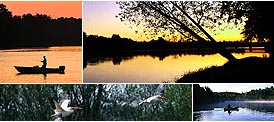
Alligator Hunting: A One of a Kind Experience -
Why They Call it Hunting Instead of Killing -
Florida's Other Crab - by Kris Thoemke
The Waiting Game - by Kris Thoemke
Mounted Memories - by Kris Thoemke
Eco-Touring in Collier County - by Kris Thoemke
Beyond the Largemouth Bass - by Kris Thoemke
Tying One On -- Some thoughts on how to get started tying your own flies -- by Kris Thoemke
The Big Cypress: Adventures in a Vast Wilderness
Four Strokes on the Water -- The sound of the future for marine outboards is likely to be much quieter --
Birding Big Cypress Swamp and the 10,000 Islands --
Recycling Your Fish -- by Kris Thoemke
Peace, Paddle and Hunt -- by Kris Thoemke
by Kris Thoemke
by Kris Thoemke
-- Kris Thoemke spends the day exploring the Big Cypress National Preserve with Preserve biologist Debra Jansen
by Kris Thoemke
by natural history writer and photographer Jeff Ripple
A Basic Guide to Saltwater Fly Fishing in Southwest Florida
C 1996, Don Phillips
Chapter 7 - Flies and Fly Tying
To the beginner, the number of fly patterns available can be intimidating ----there are probably
over 1000 different patterns used for saltwater alone. Fly selection is not a science and it will
probably never become routine. Although a particular fly may catch a dozen fish today, there is
no assurance that the same fly will produce tomorrow, next week or next year. Tides, barometric
pressure, wind, temperature etc can affect both prey species availability and gamefish inclination
to feed. No one has yet to derive the equation that produces results for all these permutations and
combinations. Thus, fly selection is a craps-shoot; sometimes you win and sometimes you lose.
What I hope to do in this chapter is to illustrate the different types of flies that can be effective,
list the patterns that seem to be the better producers, and perhaps get you interested in fly tying.
In listing the various types of flies, there is a natural inclination to categorize them by the fish
species they were designed to catch. Unfortunately, this doesn't work out well, since many if not
most of the more popular flies will catch multiple fish species. Similarly, categorizing them by
the types of prey that they imitate is not useful since many fly pattern designs are generic. I have
therefore decided to group our saltwater flies into a dozen categories which loosely define the
tying "style" or the materials used to construct them. The following paragraphs attempt to
describe these groupings and include a pictorial of a typical pattern.
- Streamers - Some of the earliest streamers were the "Ghost" series designed by Carrie Stevens to imitate the smelt species common to Maine lakes. These flies typically had slender, ribbed bodies with or without tails, wings of chicken feathers, and sometimes eyes, cheeks and beards of various other types of fur feathers.
- Bucktails - Wings tied from the tail fibers of the white-tailed deer became popular because of their durability and ease of dyeing for different color combinations. Joe Brooks' famous "Blonde" series and Harold Gibbs' well-known "Gibbs Striper" were some of the earliest adaptations of the bucktail style to saltwater fly fishing.
- Deceivers - Lefty Kreh initially designed this style for the stripers of Chesapeake Bay. This was one of the earlier attempts to tie flies with a third dimension; i.e. width. By surrounding the hook shank with bucktail he was able to give the illusion of body width without a lot of extra material (which would make it more difficult to sink). Also, the bucktail helped to prevent the wing material from fouling around the hook bend during retrieval.
- Tarpon Flies - Initially developed for Florida Keys tarpon, these flies are tied with multiple chicken feathers or saddle hackle and a dense ring of swept-backed palmered hackle at the hook bend. The main section of the hook shank was usually covered with thread or even left bare.
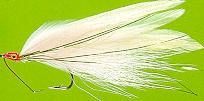



- Seducers/Whistlers - Homer Rhodes first developed the Seducers for the US East Coast. They are like the tarpon flies except that the hook shank is largely covered with palmered hackle, left upright to be less streamlined and create more disturbance in the water. On the US West Coast, Dan Blanton developed his Whistler series, which is similar to the Seducer but has many additional materials to give the fly more bulk and profile.
- Inverted-Hook Patterns - A long time ago, some bright fly tier realized that if the fly could be designed so that the hook point rode above the shank in the water, the fly wouldn't get caught on the bottom. By adding relatively stiff wing materials near the hook eye which covered the hook point, the fly became nearly weedless. Today's Keel Flies, Bendbacks, Clousers, and most bonefish flies are a result of this design philosophy. The hooks are dressed to create inversion by bending the hook, by adding weighted eyes on the hook shank opposite the point and/or by using relatively buoyant materials to cover the hook point. Any of these three techniques can change the fly's center of buoyancy and cause it to ride inverted. If tied with sparse materials, these flies can be made to sink very fast.
- Glass Minnows - Although originally designed by Carl Hansen with a flashy body wound with monofilament to create the illusion of transparency, these flies are now more generally classified as those that are very small (1/2 to 1-1/2 inches long), tied on #6-10 hooks and sparsely fitted with materials. They are usually reserved for selective fish in relatively clear water.
- Deerhair Patterns - The Muddler Minnow developed by Don Gapen was probably the first large fly pattern using spun/clipped deerhair for its head. This pattern, originally intended to imitate a sculpin or a baitfish, has now been successfully adapted to everything from grasshoppers to mice. Deer body hair readily floats because the fibers are hollow. Even when they become waterlogged they still entrap enough air to maintain a lot of buoyancy underwater, improving "action" during retrieval. Flies of this type move a lot of water and readily get the attention of hungry gamefish.
- Wool Patterns - Saltwater fly patterns using sheep's wool have gained considerable popularity in recent years. Small bunches of the longer, finer fibers can be tied on the hook and subsequently trimmed and teased to closely imitate the length-and-height silhouette of a baitfish. The shorter, coarser fibers can also be spun on the hook and clipped to create very realistic heads and bodies; especially when different-color fibers are used or when marking pens are used to paint on baitfish features. The spun-wool patterns are a little difficult to cast when they become waterlogged, but that same feature lets the fly get down deep when desired.
- Rabbit Fur Patterns - Ever since the popular Zonker pattern was developed by Dan Byford, the very flexible properties of rabbit fur have found favor with saltwater fly tiers. Narrow strips of tanned rabbit hide are either tied to the top of the hook matuka-style or palmered around the hook shank like a rooster hackle. Either technique significantly enhances the fly's profile and adds a subtle degree of motion to the fly, even when it's being retrieved slowly.
- Poppers/Sliders - These flies are a logical extension of both bass bugs and offshore lures and teasers. Although originally made from cork, they are now usually made from synthetic foam, with feathers and/or bucktail extending beyond the hook. The poppers have a concave face, which chugs and gurgles along while being retrieved, sometimes attracting fish from a considerable distance. Sliders are actually poppers turned front to rear, making somewhat more subtle noises during retrieve. These flies are particularly effective when the water is relatively cloudy, when the gamefish need to rely more heavily on sound to locate a tasty meal.
- Molded Flies - Over the past 10 years or so, considerable attention has been paid toward flies which are partially or wholly made from epoxy, hot glue or latex. Carl Richards' work with latex and Steve Bailey's and Jack Montague's creations with epoxy and hot glue are some of the more significant contributions toward the southwest Florida scene. Latex is being molded in such thin sections that fish tails and crab claws made thereof flutter and wave in a manner not unlike their feather/fur counterparts. Epoxy and hot glue (cured, of course) assists in replicating complicated shapes and in accelerating a fly's descent to the bottom.





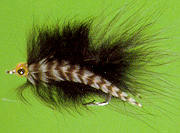


Of course, the above categories are not all-inclusive. Other styles such as worm flies, tube flies,
offshore flies etc. have not been included since they are of lesser importance to our backwater
fishing.
The popularity of specific fly patterns seems to ebb and flow as our fly fishers gain more
experience and as our fly tiers continue to innovate and refine designs. Following are the
patterns that currently seem to be receiving the most kudos from our ultimate critic, the fish:
Streamers - Hopkins Snook Fly, Mangrove Snook Fly
Bucktails - Platinum Blonde
Deceivers - Lefty's Deceiver (White, Yellow, Chartreuse), Lefty's Favorite, Cockroach, Glades Deceiver
Tarpon Flies - Black Death, DT, Cactus Baby Tarpon Fly (Purple/Black)
Seducers/Whistlers - Yellow/Red Seducer, Red/White Whistler, Blanton's Finger Mullet
Inverted Hook Patterns - Clouser Minnows, Bendbacks, Copper Liz, Redfish Threat
Deerhair Patterns - Muddler Minnow, Dahlberg Diver, Fugly, Tabory Snake Fly, Huff Backcountry fly
Wool Patterns - Woolhead Finger Mullet, Sea Devil
Rabbit Fur Patterns - Tan Mangrove Bunny, Bonito Bunny, Buck 'n Bunny, Phil's Hare-Ball Shrimp
Poppers/Sliders - Fluter
Molded Flies - Everglades Snook Fly
The above flies are generally available from our local fly shops, but if you want to fully
experience the joys of fly fishing, tying your own flies puts the icing on the cake. I still
remember catching my first trout on a fly that I tied, in the mid-1960's. As I recall the fly was
pretty primitive, but the feedback from the time spent at the tying bench was a real adrenaline
rush! Fly tying has since become an important competitor for my leisure time. It's a pastime that
fits very nicely into bad-weather days and especially evenings when TV programming is not
worth a full measure of concentration. It's also an art form that permits considerable creativity,
for those of us that can't paint or draw with any degree of proficiency. When I was in my
thirties, I regularly tied and fished flies down to sizes #18-24 and even smaller. With my current
level of visual competence, these diminutive flies would surely be difficult. On the other hand
our usual sizes of #8 to 3/0 for southwest Florida are a breeze for tired eyes and fumbling fingers.
Fly tiers generally fit into a wide spectrum of approaches. At one end of the spectrum, there are
the tiers who tie reproductions of established patterns; at the other end there are the tiers who try
to create exact imitations of a particular specie of prey. Most of us fall somewhere in between,
starting with established, popular patterns and then making modifications (improvements, we
hope) to increase their fish appeal. When you consider hook size, tying style, material, color,
proportion, weighting, degree of flash, etc you can see that there is literally no end to the
opportunities for creativity and improvement.
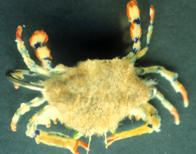
Fly tiers who seek exact replication of a particular specie of prey are individuals who must spend
many hours gathering specimens, setting up aquariums, taking macrophotographs, tying
prototypes, examining their underwater behavior and then fishing them. Most notable among
these individuals is Carl Richards, who collaborates with Doug Swisher in writing best sellers for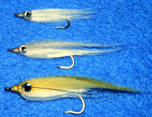 the fly fishing community. Carl lives in Michigan, but he spends several weeks down here each
year perfecting his craft. Note Carl's renditions of a crab and baitfish in these color photographs.
Still photos like these really don't do justice to these flies; only when they are under water, in
motion, do they fully illustrate the fly tier's art. Carl Richards' new book Prey provides
additional insight into the details of his techniques. If you might think that the field of prey
imitation is by now mature and fully codified---think again! The following lists the more
common prey families in our waters:
the fly fishing community. Carl lives in Michigan, but he spends several weeks down here each
year perfecting his craft. Note Carl's renditions of a crab and baitfish in these color photographs.
Still photos like these really don't do justice to these flies; only when they are under water, in
motion, do they fully illustrate the fly tier's art. Carl Richards' new book Prey provides
additional insight into the details of his techniques. If you might think that the field of prey
imitation is by now mature and fully codified---think again! The following lists the more
common prey families in our waters:
Baitfish - herring, anchovies, sardines, silversides, pilchards, pinfish, mojarra, mollies, gobies,
toadfish, hardheads, eels, tilapia, halfbeaks
Crabs - mud, blue, reef, porcelain, spider, fiddler, mole, stone
Shrimp - mantis, swimming, snapping, sponge, mud, shore, grass, lobsters
Other - sea urchins, marine worms
The above list doesn't cover all of the many species existent in these families, nor does it consider the juveniles of grunts, ladyfish, sheepshead, sail catfish, needlefish, ballyhoo, snappers, grouper, etc which are prime targets for our larger gamefish. And so, there is plenty of room for creativity and experimentation to develop more effective flies.
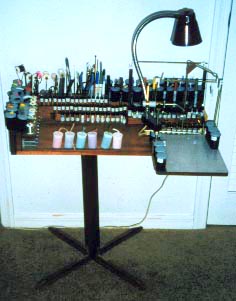
Next Month - Fly Fishing the Tides
Table of Contents












